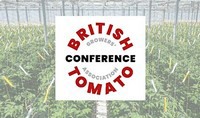The British tomato industry is navigating a challenging landscape marked by rising input costs, volatile energy markets, and post-Brexit issues. With the British Tomato Conference coming up, Phil Morley, Technical Officer for the British Tomato Growers Association, explains how, despite these obstacles, growers remain resilient and forward-thinking, with a strong focus on sustainability and innovation. “We believe the UK production of tomatoes will bounce back over the next 5 years.”
Escalating input costs
The British Tomato Growers Association (BTGA) supports their members and represents them on key issues, including promotional activity, policy, government lobbying, R&D priorities, crop protection, and much more. Over the last few years, there’s been much to talk about as the UK greenhouse market has been grappling with escalating input costs.
“Increasing energy costs over the last couple of years and the unpredictability of the energy market has been one the greatest challenges, exacerbated by inadequate government support for the primary food production industry in this respect,” says Phil. “The Brexit process and subsequent impacts on the energy market, labor availability, and crop protection provision have been key areas that have put a strain on businesses. Combined with suppressed retail prices, the global presence of the Rugose virus, and the loss of a centralized mechanism for funding applied research in the sector has made for a difficult and challenging few years.”

10% reduction will bounce back
In 2023, there was a significant 10% reduction in the area of tomatoes grown compared to the previous year. “This shift was driven by high energy costs, resulting in growers diversifying into other glasshouse crops to mitigate risks in a less profitable tomato market,” says Phil, adding they expect to more than recover in the 2024 season.
Despite the challenges, Phil is optimistic about the future of the greenhouse market in the UK. He predicts a rebound in tomato production over the next five years. “Increased demand for sustainably produced locally grown food prioritizing ongoing food security are just two drivers. Lots of indicators are very encouraging, including a significant investment in future food technologies as well as significant business investment in new facilities for protected cropping now happening in several parts of the country.” The industry is experiencing consolidation, with fewer, larger growers dominating the sector. Nevertheless, according to Phil, opportunities for new entrants exist, provided they receive support and encouragement from the UK government.
He adds UK growers remain forward-thinking and motivated to invest in the future when funds allow, including innovative technology. “A current primary focus being reaching Net Zero production.” Also, they are actively reaching out to the consumer. “To promote our great British produce, each year during peak season, we also have a campaign, British Tomato Fortnight. This initiative has received increasing attention over recent years and highlights the wonders of the Great British tomato, educating our home consumers about the positive health and general sustainability benefits of homegrown produce.”
Crop protection framework
And there are more initiatives to keep the sector thriving. Following the loss of the Statutory levy to fund R&D and Crop Protection work in the UK, growers have come together to address crop protection and developed a framework and strategy to continue this work. “This is done through the formation of Horticulture Crop Protection Ltd. Grower governed and funded, this organization currently focuses on the licensing of existing and new plant protection products so vital to crop production. Likewise, we are also working on a cross-sector organization to address the absence of grower-funded R&D in the UK-protected edibles sector.” The BTGA itself continues to widen its lobbying activities alongside the UK’s National Farmers Union (NFU). “This provides direct access to government organizations and individuals to help us influence the ‘bigger picture’ policy and future direction of UK Horticulture.”
He emphasizes the industry seeks a coherent food production strategy from the government that values primary food producers and offers support and clarity on the challenges they face. “The industry needs clarity from government into how they are going to demonstrate they value primary food producers and provide support and clear understanding of the threats and challenges faced to ensure a thriving sector, which would ultimately attract the best workforce.”
Rugose
In regards to the Rugose virus, the UK growers continue to collect, collate, and communicate information on the virus through the UK Working Group on ToBRFV and the associated information portal. “We’re helping growers to better understand the virus and prevent infection by whatever means possible – but the virus continues to be a significant threat to the industry until commercially acceptable cultivars with full resistance are available,” Phil says. Also, aside from the virus, growers unite to combat challenges. The BTGA has its own ‘Technical Committee of Experts’, on which sits many of its grower members. “We meet regularly to formulate our own policy and positions on current issues, including pest and disease management, technology and robotics, and the wider research and development picture.”
The BGTA itself is working to better integrate its activity and collaboration across the protected edible sector, not just tomatoes. “To increase our presence, influence, and ability to champion positive change for the sector. We would also like to continue to form relationships with European growers and research organizations to work together and share our joint future prosperity.”
Looking Ahead The annual British Tomato Conference, set to take place on September 21 in Warwickshire, offers a platform for industry stakeholders to share experiences, network, and gain insights from expert speakers. The event promises to address many of the challenges and opportunities discussed in the article above and will also welcome market intelligence company Kantar, who will discuss the British Tomato Market and wider consumer picture in depth – the characteristics, challenges, and opportunities.
The annual British Tomato Conference, set to take place on September 21 in Warwickshire, offers a platform for industry stakeholders to share experiences, network, and gain insights from expert speakers. The event promises to address many of the challenges and opportunities discussed in the article above and will also welcome market intelligence company Kantar, who will discuss the British Tomato Market and wider consumer picture in depth – the characteristics, challenges, and opportunities.
This year’s event takes place on September 21 in Warwickshire, and Phil promises it is to be one of the best events of recent years.
Click here for more information and tickets:
To exhibit or sponsor the event:
[email protected]










